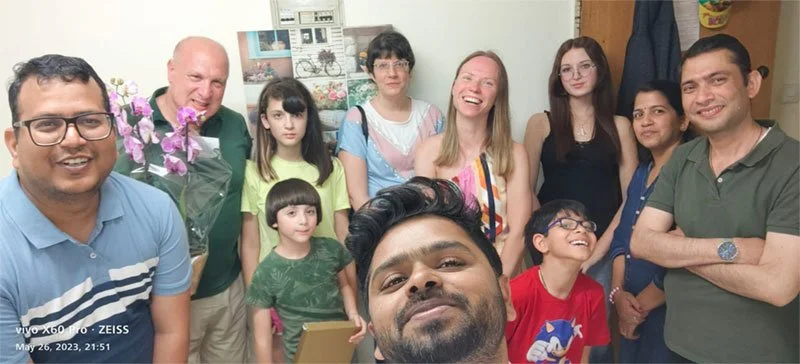Q&A with Or Kakhlon, PhD
December 14th, 2024
Dr. Or Kakhlon is an associate professor in the Department of Neurology at Hadassah-Hebrew University Medical Center and a long-standing member of the APBD Research Foundation’s Scientific Advisory Board. He has been an important contributor to APBD research, co-authoring over ten APBD publications within the past decade alone.
In 2023, Dr. Kakhlon received a Million Dollar Bike Ride grant titled “Combinations of Small Molecules as Potential Therapeutic Agents for APBD.” Dr. Kakhlon aims to enhance promising compounds for treating APBD; and establish new biomarkers, including neurofilaments and metabolites.
We interviewed Dr. Kakhlon recently to give you a chance to get to know him and more about the innovative APBD research being done at the Hadassah-Hebrew University Medical Center.
Or Kakhlon’s Laboratory Team and Their Families Share Smiles at a Recent Get-Together
Q: What inspired you to pursue this field of research?
Dr. Kakhlon: Similar to other orphan (or rare) disorders, APBD has remained an under-recognized disease for decades. In addition, as an adult-onset disorder, it receives much less support from funding agencies and from pharma companies because it is less cost-effective to search for a cure for an adult disorder as opposed to a pediatric disorder. For these reasons, I felt that APBD patients will remain stuck without any therapeutic options on the horizon unless researchers like myself engage in an endeavor to find a cure for APBD.
Q: Your work focuses on how three small molecule therapies, GHF201, GHF205, and guaiacol, affect mice at different time points, as well as how they affect mice independently and in combination with each other. Why is this area critical?
Dr. Kakhlon: Experimenting with the dose of the test compounds both before and after onset should reveal whether these compounds have a preventive or corrective effect.
Since we know how the compounds work on a molecular level, hopefully experimenting with different combinations, both at different times, and with different types of compounds, will provide insights about which approaches are more effective in ameliorating APBD symptoms.
We hope to see that compounds designed to degrade polyglucosan bodies, when combined with those that prevent polyglucosan body formation, can work together to enhance the individual benefits of each.
Q: How is the research progressing so far?
Dr. Kakhlon: Our APBD model mice have been treated for several months both pre- and post-onset. At the moment, we are in the midst of running behavioral and nociceptive (perception/sensation) tests on pre-onset treated mice. We still need to euthanize these mice and run several analyses on tissues collected from them. We are hoping to complete post-onset dosing and perform behavioral, nociceptive, histological and metabolic tests on them by the end of February 2025.
This research is unique in the sense that results can only be known after dosing and subsequent analyses are completed. We cannot report the results until all longitudinal and staggered experiments are completed. This requires patience, but there is no other choice for such longitudinal studies.
Q: What challenges have you encountered in this project?
Dr. Kakhlon: So far, the main challenge has been that it took longer than expected for our mouse mating schedule to produce enough mice to be able to randomize animals of the same age at the initiation of the study. Other than that, we have not encountered major challenges. GHF201, GHF205 and Guaiacol are very well tolerated and have no specific side effects that we are concerned about.
Q: Your research has important implications for clinical trials in APBD. Can you tell us more about this?
Dr. Kakhlon: Yes. I think compound combinations and dosing schedules are very important for future use in clinical settings. For instance, this work will help us determine whether APBD patients should pursue compounds dosed in combination or separately. Another important consideration is determining the order in which the compounds should be taken by the patients. For example, will pre-treatment with a polyglucosan degrading compound (GHF201), followed by post-onset treatment with an inhibitor of glycogen synthesis (guaiacol, or GHF205) have the same therapeutic effect as this post-onset treatment alone? Our results could demonstrate, for instance, that pre-onset degradation of polyglucosans can amplify, or even enable, the therapeutic effect of post-onset inhibition of glycogen synthesis.
Thank you, Dr. Kakhlon. We wish you much success on behalf of our community!

